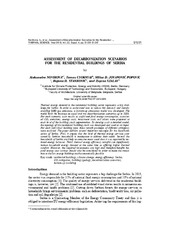Prikaz osnovnih podataka o dokumentu
Assessment of decarbonisation scenarios for the residential buildings of Serbia
| dc.creator | Novikova, Aleksandra | |
| dc.creator | Csoknyai, Tamas | |
| dc.creator | Jovanović-Popović, Milica D. | |
| dc.creator | Stanković, Bojana D. | |
| dc.creator | Szalay, Zsuzsa | |
| dc.date.accessioned | 2020-12-06T19:59:09Z | |
| dc.date.available | 2020-12-06T19:59:09Z | |
| dc.date.issued | 2018 | |
| dc.identifier.issn | 0354-9836 | |
| dc.identifier.uri | https://raf.arh.bg.ac.rs/handle/123456789/1085 | |
| dc.description.abstract | Thermal energy demand in the residential building sector represents a big challenge for Serbia. In order to understand how to reduce this demand, and thereby avoiding GHG gas emissions, a bottom-up simulation model was developed. The model built the business-as-usual and two decarbonization scenarios up to 2030. For each scenario, such results as useful and final energy consumption, associated CO2 emissions, energy costs, investment costs and others were prepared at each level of the building stock segmentation. To develop such a detailed model, the topology of the residential building stock was developed and used as an input. For each individual building type, three retrofit packages of different stringency were analyzed. The paper delivers several important messages for the decarbonization of Serbia. First, it argues that the level of thermal energy services consumed by Serbian households is inadequate to address their needs. Second, the households of Serbia are likely to consume more wood than it was reported by national energy balances. Third, thermal energy efficiency retrofits can significantly reduce household energy demand at the same time as offering higher thermal comfort. However, the required investments are high and therefore benefits beyond energy cost savings should also be considered in order to make the transition to the low energy building stock economically feasible. | en |
| dc.language.iso | en | sr |
| dc.publisher | VINCA Institute of Nuclear Sciences | sr |
| dc.rights | openAccess | sr |
| dc.rights.uri | https://creativecommons.org/licenses/by-nc-nd/4.0/ | |
| dc.source | Thermal Science | sr |
| dc.subject | Residential buildings | sr |
| dc.subject | Climate change | sr |
| dc.subject | Energy efficiency | sr |
| dc.subject | Serbia | sr |
| dc.subject | CO2 mitigation | sr |
| dc.subject | Building typology | sr |
| dc.subject | Decarbonization scenarios | sr |
| dc.subject | Bottom-up modeling | sr |
| dc.title | Assessment of decarbonisation scenarios for the residential buildings of Serbia | en |
| dc.type | article | sr |
| dc.rights.license | BY-NC-ND | sr |
| dcterms.abstract | Новикова, Aлександра; Цсокнyаи, Тамас; Јовановић-Поповић, Милица Д.; Станковић, Бојана Д.; Сзалаy, Зсузса; | |
| dc.citation.volume | 22 | |
| dc.citation.issue | Suppl. 4 | |
| dc.citation.spage | 1231 | |
| dc.citation.epage | 1247 | |
| dc.citation.rank | M22 | |
| dc.identifier.wos | 000450540300023 | |
| dc.identifier.doi | 10.2298/TSCI171221229N | |
| dc.identifier.scopus | 2-s2.0-85057075257 | |
| dc.identifier.fulltext | https://raf.arh.bg.ac.rs/bitstream/id/3756/StankovicBMPopovic.pdf | |
| dc.type.version | publishedVersion | sr |

